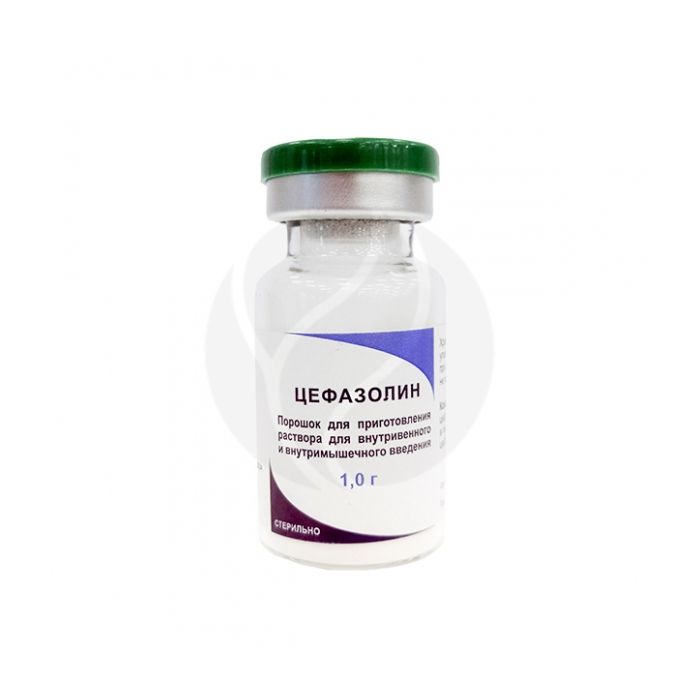Cefazolin powder d / prig.r-ra d / i / v and i / m administration 1.0 g, No. 1
Expiration Date: 05/2027
Russian Pharmacy name:
Цефазолин порошок д/приг.р-ра д/в/в и в/м введения 1,0г, №1
Infectious and inflammatory diseases caused by microorganisms sensitive to cefazolin, incl.
diseases of the upper and lower respiratory tract,
urinary and biliary tract,
pelvic organs, skin and soft tissues, bones and joints,
endocarditis,
sepsis,
peritonitis,
otitis media,
osteomyelitis,
mastitis,
wound,
burns and postoperative infections,
syphilis,
gonorrhea.
Set individually, taking into account the severity of the course and localization of the infection, the sensitivity of the pathogen.
Enter i / m or i / v (jet or drip). The average daily dose for adults is 1 g, the frequency of administration is 2-4 times / day. For the prevention of postoperative infection, a dose of 1 g is administered 30 minutes before the operation, 0.5-1 g during the operation and 0.5-1 g every 6-8 hours during the day after the operation.
Maximum dose: 6 g / day. For children, the average daily dose is 20-40 mg / kg; in severe infections, the dose may be increased to 100 mg / kg / day. The duration of treatment is 7-10 days.
Powder for the preparation of a solution for intravenous and intramuscular administration of white or white with a yellowish tinge, crystalline; solvent - a clear, colorless liquid, odorless.
1 fl. cefazolin (in the form of sodium salt) (in terms of cefazolin) 1 g
Solvent: water d / i - 5 ml.
Hypersensitivity to cephalosporins.
pharmachologic effect
A cephalosporin antibiotic of the 1st generation with a broad spectrum of action. Has a bactericidal effect. Active against gram-positive bacteria: Staphylococcus spp. (strains producing and not producing penicillinase), Streptococcus spp. (including Streptococcus pneumoniae), Corynebacterium diphtheriae, Bacillus anthracis; gram-negative bacteria: Neisseria meningitidis, Neisseria gonorrhoeae, Shigella spp., Salmonella spp., Escherichia coli, Klebsiella spp. It is also active against Spirochaetoceae, Leptospira spp. Inactive against Pseudomonas aeruginosa, indole-positive strains of Proteus spp., Mycobacterium tuberculosis, anaerobic bacteria.
Pharmacokinetics
Cefazolin is poorly absorbed from the gastrointestinal tract and is therefore used IM or IV. After intramuscular administration at a dose of 500 mg, Cmax in plasma is reached after 1-2 hours and is 30 ?g / ml. Plasma protein binding is about 85%. Cefazolin penetrates into bone tissue, ascitic fluid, pleural and synovial fluids, but is not detected in the central nervous system. T1 / 2 of cefazolin from plasma is about 1.8 hours. Cefazolin is excreted in the urine unchanged, mainly by glomerular filtration and, to a small extent, by tubular secretion. After i / m administration, at least 80% of the dose after i / m administration is excreted after 24 hours. After i / m administration in doses of 500 mg and 1 g, Cmax in urine is 1 mg / ml and 4 mg / ml, respectively. There is evidence of a high concentration of cefazolin in bile, although it is excreted in this way in small quantities.T1 / 2 from plasma increases in patients with impaired renal function.
Side effect
From the digestive system: nausea, vomiting, diarrhea are possible; rarely - a transient increase in the activity of hepatic transaminases. Allergic reactions: urticaria, pruritus, eosinophilia, fever are possible; in isolated cases - Quincke's edema, arthralgia, anaphylactic shock. Effects due to chemotherapeutic action: candidiasis, pseudomembranous colitis. From the hematopoietic system: rarely - reversible leukopenia, neutropenia, thrombocytopenia. From the urinary system: rarely - impaired renal function. Local reactions: soreness at the site of the intramuscular injection is possible.
Application during pregnancy and lactation
Penetrates the placental barrier. In breast milk, low concentrations of cefazolin are determined.
Application during pregnancy and lactation
justified only in cases where the expected benefit to the mother outweighs the potential risk to the fetus or child.
Application for impaired renal function
Use with caution in case of impaired renal function.
Application in children
Contraindicated in children under 1 month of age. Application in children older than 1 month is possible according to the dosage regimen.
special instructions
Use with caution in case of impaired renal function. In patients with hypersensitivity to penicillins, allergic reactions to cephalosporin antibiotics are possible. During the treatment period, a false-positive urine reaction to sugar is possible. Cefazolin is excreted during hemodialysis.
Drug interactions
When used simultaneously with 'loop' diuretics, the tubular secretion of cefazolin is blocked (this combination is not recommended). Cefazolin can cause disulfiram-like reactions when used simultaneously with ethanol. Probenecid interferes with the excretion of cefazolin.

